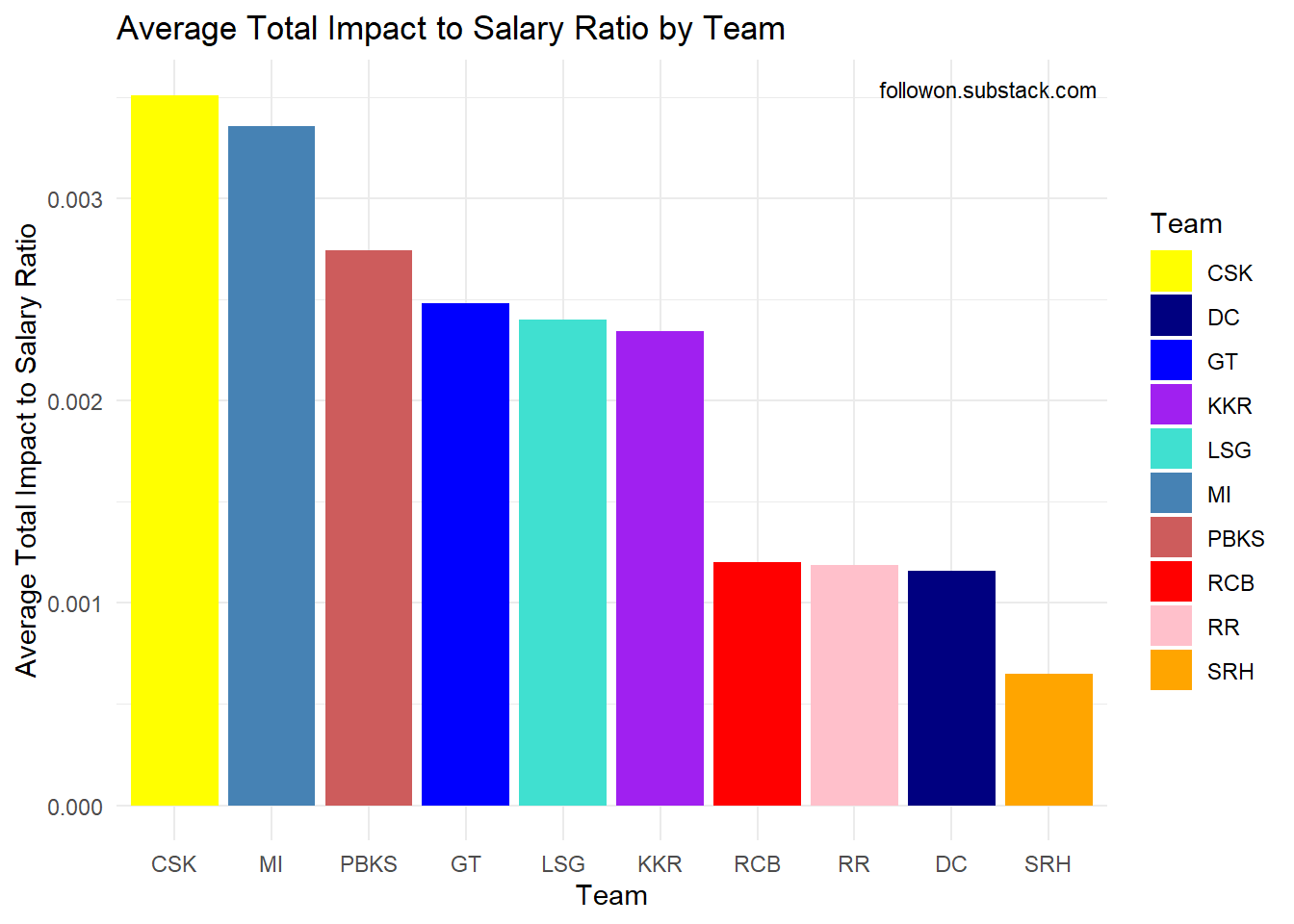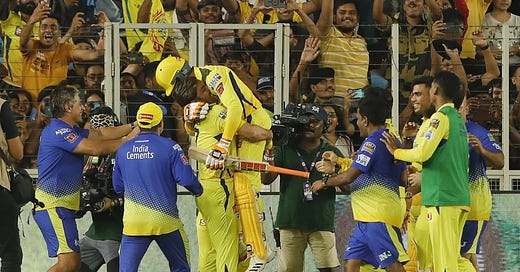Bang for Buck: Who were IPL 2023's Most and Least Cost-Efficient Players?
In analyzing player salaries and performance, we reveal insights into the relationship between value for money and player impact in this year's tournament.
IPL 2023 is now over, with MS Dhoni’s Chennai Super Kings winning for a fifth time, concluding what has been one of the most entertaining editions of the tournament.. Players were more expensive than ever, with the stakes for those marquee players higher than ever, and yet, Chennai was able to win the 16th edition of the tournament without their most expensive player, Ben Stokes, who they purchased for ₹16.25 crore (roughly US$2.0 million). Stokes accounted for a little over 18% of the team’s salary cap, and yet with him only playing two games before being ruled out for injury, Chennai still managed to lift the cup.
Based on that one example, one could conclude that there’s not really a correlation between a player’s salary and how valuable they are to their team in terms of performance. However, you really shouldn’t jump to conclusions based on just a single case. In order to draw a valid conclusion we need to evaluate the relationship between salary and Match Impact for every single player in this year’s IPL.
The metric we’ll be using is ESPNCricinfo’s Total Impact model, which is described as “a numerical value which is the sum of [the player’s] Batting and Bowling Impacts. These Impacts are calculated based on the context of a batting/bowling performance.”
We will limit our analysis to players who played more than five games, because a decent sample size is always needed to draw conclusions from a player’s performance. Additionally, comparing the Total Impact for a player who played 17 matches as opposed to somebody who only played 5 matches is unfair, as the former had significantly more opportunities to rack up Total Impact points. Therefore, to look at every single player on an equal scale, we will use Impact per Match.
Here it is:
Hm. Perhaps your Ben Stokes-related hunch was correct. Feel free to jump to baseless conclusions in the future. You are always correct, and you are also better than everyone around you.
In this year’s IPL, there was no discernible connection between the salary of a player and their average Impact per Match. The coefficient of determination, or measure that provides information about the goodness of fit of a model for this sample, is only 0.045. A value of 0 means that the model explains or predicts 0% of the relationship between the dependent and independent variables, and we’re pretty damn close to 0 here.
So, on the whole, recruitment in this year’s IPL from a purely economic standpoint did not work. Players seemed to randomly perform well in no relation to their salary, meaning that this is all just luck, right?
Well, no. For example, Team A spends a million dollars on Rashid Khan, and Team B spends a million dollars on you. Rashid Khan is arguably the best T20 cricketer in the world, so that’s a great purchase. That being said, just because you are worth the same amount of money as Rashid Khan, you are not even close to being the best T20 cricketer in the world.
Essentially, different teams spent better in order to be more cost-efficient. This isn’t a revolutionary line of thinking, obviously, but I’m sure you're curious as to which teams were actually most efficient.

As you can see in this graph, CSK still managed to have the best Total Impact to Salary Ratio of any team in the IPL without Ben Stokes. Of course, a high score here actually becomes easier to achieve because of Stokes’ price tag. The order in this graph is incredibly similar to the actual IPL table, with the actual top four of this year’s IPL finishing in the top five of this graph (if you want to read about how unlucky and/or stupid the Punjab Kings were this season, click here), and Delhi Capitals and Sunrisers Hyderabad replicating their places at 9th and 10th on the points table, respectively.
With all that in mind, I think it’s time to finally look at who were the IPL’s most and least cost-efficient players. This will help us reward players who far exceeded their expectations (read: price tag), and also feel remorse for the players who performed far worse than their expectations. This time around, we’re not going to use Impact per Match, because 1) we’re not directly comparing players who played vastly different numbers of games against one another to evaluate a trend and 2) availability is also an asset; the more games you play, the more valuable you are. We’ll stick to Total Impact (divided by Salary), but will maintain the 5 match minimum limit, in order to ignore players like Mark Wood, who only played 4 games this season but managed the best Impact per Match score of anybody in this year’s IPL.
Shall we start with the best or worst? Frankly, I’m eager to hate.
IPL 2023’s Least Cost-Efficient Players
5. Harry Brook (Sunrisers Hyderabad)
Despite a blazing century against Kolkata Knight Riders, only scored 190 runs at an average of 21.11 and strike rate of 123.38. Struggling against spin throughout the tournament, Brook failed to justify his lofty ₹13.25 crore (US$1.7 million) price tag. He has the potential to bounce back stronger, but IPL 2023 was certainly a season to forget.
4. Rahul Tewatia (Gujarat Titans)
Tewatia’s statistics are actually not bad at all: he struck at 152.63 and managed an average of 21.75, which is pretty good for a middle order batter. The issue is that all of this resulted in only 87 runs off Tewatia’s bat. Tewatia’s lack of value in this tournament was less due to any fault of his own and more just that in being placed last in the order amongst Gujarat Titans’ main batters, he only faced 57 balls. He also bowled 13 balls of leg spin this season, meaning that with his ₹9 crore (US$1.1 million) salary in mind, Tewatia averaged roughly ₹12.86 lakh (US$15,550.82) per direct ball involvement. What a waste.
3. Shahbaz Ahmed (Royal Challengers Bangalore)
Shahbaz Ahmed’s salary is ₹2.4 crore (US$300,000), a relatively low number relative to many other IPL players. The reason he ranks so low amongst his peers is because his performances in IPL 2023 were outright terrible. Ahmad scored 42 runs at an average of 10.50 and strike rate of 107.69, while also only taking one wicket with his offspin, averaging 95.00 with the ball while conceding 13.57 runs per over.
2. Yash Dayal (Gujarat Titans)
Yash Dayal wrote his name in the history books this season, conceding five consecutive sixes to Rinku Singh to lose the game for Gujarat Titans. Even when we look at his other performances, his season was still one he will try to move past. Despite earning ₹3.20 crore (US$400,000), the pace bowler only took two wickets in his five games this season, averaging 82.50 with the ball and conceding 11.79 runs per over.
1. Deepak Hooda (Lucknow Super Giants)
In last season’s IPL, Hooda scored a mammoth 451 runs, getting an opportunity for the Indian team and taking it, scoring a century against Ireland while opening the batting. His form did not continue in this year’s season, where Hooda only scored 84 runs, averaging 7.64 and striking at 93.33. With a salary of ₹5.75 crore (US$720,000), Hooda stands out as IPL 2023’s least cost-efficient player.
Now, with all that hate behind us, it’s time for celebration.
IPL 2023’s Most Cost-Efficient Players
5. Suyash Sharma (Kolkata Knight Riders)
Suyash Sharma is one of the most notable beneficiaries of the new Impact Player rule, playing 11 matches for Kolkata despite only being paid ₹20 lakh (US$25,000). The mullet-haired wrist spinner picked up 10 wickets at an average of 32.10 while only conceding 8.23 runs an over. At only 20 years old, Sharma’s future poses great interest.
4. Noor Ahmad (Gujarat Titans)
Noor Ahmad joined his Afghan compatriot Rashid Khan in Gujarat Titans’ exceptional bowling attack, with the left handed wrist spinner taking 16 wickets at an average of 23.06 while being an absolute miser, conceding only 7.82 runs per over. He capped the tournament off with one of the greatest spells in IPL finals history, taking two wickets and only conceding 17 runs in a match with a run rate of 11. Additionally, Ahmad is only 18 years old, inspiring great envy in me.
3. Matheesha Pathirana (Chennai Super Kings)
Despite the hefty expectations of being Lasith Malinga’s slingy Sri Lankan successor, Pathirana performed exceptionally well this IPL. Taking 19 wickets at an average of 19.53 while only conceding 8.01 runs per over, Pathirana definitely deserved more than just the ₹20 lakh (US$25,000) salary he received this season.
2. Jitesh Sharma (Punjab Kings)
Jitesh Sharma announced himself to the world in last year’s IPL, proving to be one of the best middle order batters in the competition. He continued his great form this year, scoring 309 runs while averaging 23.77 and striking at 156.06. Just as consistent as his performances was his salary, still a mere ₹20 lakh (US$25,000). With form like this, one has to wonder if an India call-up is on the cards for Jitesh Sharma.
1. Tushar Deshpande (Chennai Super Kings)
Despite a seemingly high economy rate of 9.92, Deshpande was less than a run above this season’s average run rate of 8.99. In exchange for being slightly expensive, Deshpande took a whopping 21 wickets with his right arm pace bowling. Deshpande consistently took the wickets of important batters, serving as a truly “clutch” player for the Chennai Super Kings. It’s all made even better considering that he was bought in the last mega auction at base price, or ₹20 lakh (US$25,000).
In evaluating the finances regarding a player in conjunction with their performance, we’re able to assess the quality of recruitment in regards to their purchase. As we’ve seen, the standard of recruiting in the IPL is still scattershot, but specific teams have pulled ahead by being smart with how their money is spent. Frankly, you don’t even have to be that smart to pull ahead. After all, the Chennai Super Kings got away with spending ₹16.25 crore on Ben Stokes.






